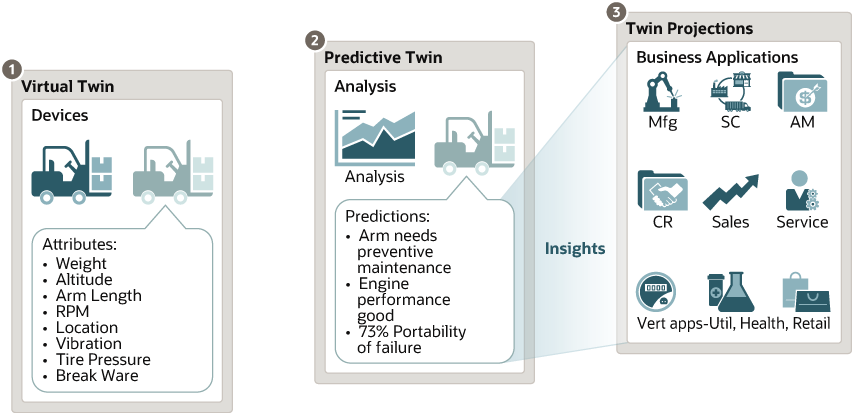About the Oracle IoT Digital Twin Implementation
The Oracle IoT digital twin implementation has three pillars, each of which has its own use cases and advantages.
Elements of the Oracle IoT Digital Twin Implementation
The image illustrates the three pillars. The three pillars help solve different kinds of problems and offer different advantages.

Description of the illustration iot_digital_twin_implementation.eps
Virtual Twin
In a virtual twin, Oracle’s device virtualization feature creates a virtual representation of a physical device or an asset in the cloud. A virtual twin uses a JSON-based model that contains observed and desired attribute values and also uses a semantic model.
Applications and Use Cases
-
An IoT application may not be able to connect to the physical asset. In such a scenario, the application must be able to retrieve the last known status and to control the operation states of the asset.
-
Typically, devices use a variety of protocols and methods to connect to the IoT network. This complexity should not affect other business applications such as an enterprise resource planning (ERP) application. Device virtualization provides an abstraction layer that enables typical business applications to securely communicate with devices.
-
The semantic model lets you specify the normal operating range of an attribute. This results in a simpler implementation of edge computing.
-
The business rules that you declaratively define on top of the complex event processing (CEP) engine in Oracle IoT Cloud Service can be automatically invoked at the edge of the IoT network.
Example: Typically, to detect threshold violations of a device attribute such as the temperature, a developer writes a separate application to process this information. The user then has to manage and maintain the application. With device virtualization, the device model detects abnormalities and generates appropriate alerts, eliminating the need to write and deploy a separate edge-computing program.
-
The semantic awareness built into the device model optimizes the delivery mechanism and the volume of network traffic.
-
Compared to the typical approach of using efficient protocols such as MQTT, a semantic model significantly reduces the cost of network bandwidth by automating statistical modeling at the edge.
Example: In a fleet of connected automobiles, an IoT application monitors a collection of operating parameters. The semantics-based model enables the edge to:-
Decide whether the operating parameters are in normal range.
-
Identify whether each message is urgent, important, or routine. The edge can intelligently detect that a break-failure notification is an urgent message, a low pressure in tire is an important message, and oil viscosity is slowing is a routine message.
-
Determine whether to send an alert message over a cellular network or download the device data when the vehicle connects to a Wi-Fi network at the end of a shift.
-
Predictive Twin
In a predictive twin, the digital twin implementation builds an analytical or statistical model for prediction by using a machine-learning technique. It need not involve the original designers of the machine. It is different from the physics-based models that are static, complex, do not adapt to a constantly changing environment, and can be created only by the original designers of the machine.
Applications and Use Cases
-
When the model detects a future problem or a future state of a machine, then you can prevent or prepare for them.
-
You can use the predictive twin model to determine trends and patterns from the contextual machine data. The model helps you address business problems.
-
A data analyst can easily create a model based on external observation of a machine and can develop multiple models based on the user’s needs.
-
The model considers the entire business scenario and generates contextual data for analysis and prediction.
-
The IoT applications can generate contextual data not only from the machine data but also from the various business applications that are integrated with it. The models created from this data are effective and usable.
-
The predictive models vary from being simple to complex based on the business problem that you want to solve.
Examples
-
Oracle IoT Cloud Service includes the Oracle Stream Explorer, an event-processing engine, and uses it to create a simple model based on trends and patterns in the data.
-
Oracle IoT Cloud Service uses Apache Spark-based analytics for complex models. To generate time-series data, you can use the additional libraries for Apache Spark in Oracle IoT Cloud Service.
-
A data scientist can create a complex model by using Oracle R Advanced Analytics for Hadoop (ORAAH) and then execute it in the IoT data pipeline.
-
A business user can use the user-friendly interface of the Oracle Big Data Discovery product to create simple models.
-
Twin Projections
In twin projections, the predictions and the insights integrate with back-end business applications, making IoT an integral part of business processes.
-
Native pre-built integrations with Oracle ERP and Oracle CX applications
-
Integration with 150 applications by using Oracle Integration Cloud Service (ICS)
-
Integration using REST API libraries
Applications and Use Cases
-
You can generate insights in the IoT platform and integrate them with business processes.
-
When projections are integrated with a business process, they can trigger a remedial business workflow.
-
Business applications can have access to the transactional and contextual IoT data that they need for their decisions.
-
Business applications can monitor the predicted state of the machines and their environment.
Advantage
Prediction data offers insights into the operations of machines. Projecting these insights into the back-end applications infrastructure enables business applications to interact with the IoT system and transform into intelligent systems.